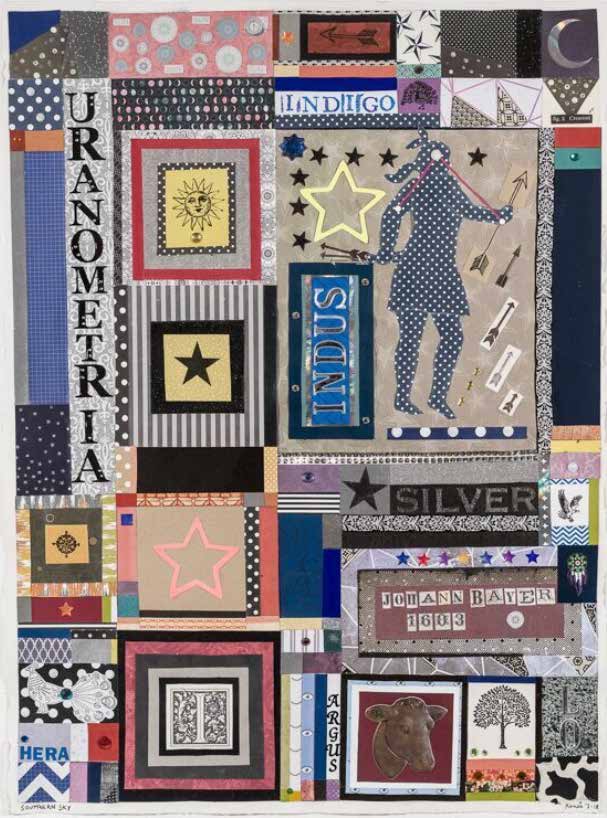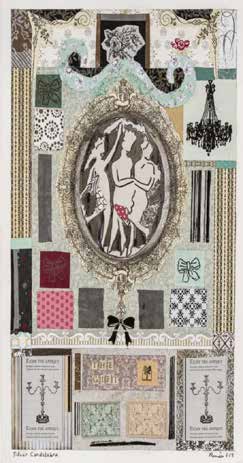Renée Borkow is an artist whose oeuvre encompasses a wide range
of media. In this exhibit, “Step Out of Time” at Viridian Artists, she examines women’s positions throughout history in the western world in masterful collages where the topic is Greek mythology. More specifically, the roles of the goddesses in the fabled celestial pantheon are scrutinized, with the artist providing particular examination of the wife of Zeus, the formidable Hera.
Renée Borkow confides that this body of work is the result of reflections
on her reading of The Odyssey, along with her thoughtful personal artistic
development of efforts from an earlier series of graphic and painted images. The inspiration arises from when she gazed at an illuminated looking glass, where impetus for the pieces was the creative epiphany she realized from the mirror’s echo of self. Her thoughts moved to the mythological actors, the divine women always there, supporting and reacting to peripatetic and frequently male gods on Olympus. Here, the majority of the collages on paper bring the gods back to earth and, in contrast exalt the goddesses’ positions through strong and wise portrayals of the feminine—most importantly showing Hera regally and divinely in command, rather than as the harridan and bane of Zeus’s existence.
The artist’s imagery is rich and complex, with Borkow’s alluding to
Botticelli’s “Primavera,” in the majority of the collages, showing the Three Graces as wonderful muses in charge of the gods’ palace banquets to bring joy, beauty and meaning to life. But, there is a duality in these Graces as one could also view them as Fates, with Hera in the middle of the trio, angry at Aphrodite and contributing to the beginning of the Trojan War through the Judgement of Paris.
However, Ms. Borkow softens this possibility, portraying Hera sympathetically, and places this goddess in the celestial firmament as the
constellation of the glorious peacock, her mythological symbol. Referring to
Pavo, another name for this regal bird in “Heavenly Hera,” and also as Indus in the constellation by the same name in “Southern Sky,” the artist gives us major clues to the pieces’ meanings. Hera, in contrast to her historically being seen as a meddling woman, is now the mighty queen journeying across the universe in her chariot pulled by peacocks, her head below a magnificent diadem. Indus in “Southern Sky” holds arrows and represents Io, worshipped in Egypt as Isis. The peacock’s plumage in this constellation is really the eyes of Hera’s servant, Argus, placed in the bird’s feathers, as patterns symbolic of the goddess watching the heifer and not
trusting her, because of her dalliance with Zeus. Borkow makes peacocks the main motifs used to intricate compositional advantage in sublime visual variations.

It is prescient that this exhibit happens at the same time as the first
translation of The Odyssey by a woman, providing a view of the Greeks from a female perspective giving voice to the feminine sensibility. Throughout the poem, we see that Athene’s intelligence is foremost as she rescues the wily wandering hero from all his trials on his journey back to constant Penelope. Penelope shows another aspect of Celestial Musings
Southern Sky, 27¼”x35½”, collage, 2018 intelligence as patience and guile, keeping the terrible suitors at bay, repeatedly weaving her father-in-law’s cloak at night in her chamber, awaiting her husband’s return. Aphrodite is beautiful but immoral. Her jealousy of Psyche’s fair aspect causes the goddess to make Eros and the young woman suffer. Borkow alludes to Psyche’s luxuriant experience at the banquet in the palace in a depiction
of a huge diamond gem in “The Gift.” All ends well for the lovers with the
artist showing the “True Colors” of love in, its many aspects with glorification of Hera’s real worth, as the archetype of marriage’s sense of faithfulness in the repetition of the image of the beautiful peacock in the piece. The work “Presto” celebrates happiness too, glorifying the arts that give sense to life. Renée Borkow also emphasizing felicitousness in her
depiction of Charis in the Greek giving of gifts in the pieces, “A Rose,” and “The Gift.” However, in the latter work we again are reminded of duality in the duplicity of Odysseus’s present of The Trojan Horse at Troy.
The artist’s eureka moment, when gazing at the mirror, helped her make
this creative outing at Viridian Artists an opportunity to depict women not
primarily as reflections of a patriarchal society passed down historically up to our modern day, but instead as the vanguard for a new respect for the sanctity and real value of the female half of the sky. Hera is not a shrew but rather she is seen as the magnificent sovereign of the heavens, responsible for the origins of the Milky Way, who, when she was raped by Zeus to force marriage and in constant pain from Heracles’ arrows, is triumphant over
the adversity that has befallen her—just as women throughout history prevail in spite of so many obstacles placed before them by men.
Renée Borkow names the ambivalence with which women are seen through the lens of men’s eyes in all and the collages are accomplished in perfect compositional balance, with all the depictions arranged as if they were
parts of Victorian graphic advertisements with post-modernist influences. The images are elegantly and tightly realized but their underlying messages are statements of dramatic power. This is most evident in the piece, “Butterfly,” where the female torso is constricted in a lace nineteenth century corset, with arrows, hearkening back to “Southern Sky,” jabbing at the tight waist of the garment. In contrast with this image’s violence, butterflies float throughout the piece, beautiful symbols of the soul
wandering and thirsting for love, just as Eros and Psyche longed for ethereal bliss to bless their union in spite of jealousies. This juxtaposition underscores the duality of how women have been viewed down the ages as temptresses and divine entities to be revered and simultaneously loathed because of their primal force, the artist examining both feminine inherent mystical power and the woman’s subservient position.

The artist surreptitiously underscores this ambivalence again in the pieces
“Columns and Candelabras” and “Silver Candelabra,” where in the former the chairs are emblematic of regal seats for queens from which they ruled, but also hearken back to Hera’s confinement, by Hephaistos, to a magical throne which she could not leave until released by him, once he was given Aphrodite for a wife. Here again, the woman’s power is compromised and the woman, in this case, Hera, must receive permission to rise from her chair. Hephaistos grants power to the matriarchal woman if he is rewarded by acquiring an inconstant aspect of love in his fickle wife. Io, in the form of Isis, also refers to the queenly throne, but here Isis is the savior, resurrecting the murdered Osiris as the foundational event in Egyptian
mythology, as she honors him by wearing a throne on her head. The candelabra becomes a dual symbol too, as both a decorative object and a very necessary provider of illumination, like women who are the modern day “trophy” wives and also are the obligatory power behind men’s thrones.
Ms. Borkow also explores the scientific and symbolic meaning of the work by referring to Johann Bayer in “Southern Sky” and Claude Levi-Strauss
in the piece, “A Rose.” Levi-Strauss exhaustively studied the ramifications
of myth and Bayer classified the stars in the Uranometria. Again, the artist
presents a duality by including a scientist who identifies the constellations and one who interprets them as stories about the human condition. We are witnesses to both fact and fiction at the same time.
In looking at this treasure trove of imagery, I was struck by the artist’s broad frame of reference in both iconography and narrative and by the levels of meaning which are too broad to give a detailed telling of in the few words provided here. Renée Borkow explores important issues about women’s worth in the world in so many ways, that all started with the artist’s gaze in the mirror inspiring her thoughts after reading tales of Odysseus. The artist places women at the forefront of all times and one hopes these pieces, at Viridian Artists, foretell further serious and marvelous studies by Renée Borkow in the days ahead about what it means to be feminine in all its divine glory.
—Anne Rudder
Renée Borkow, “Step Out of Time”
Viridian Artists, Inc.
548 West 28th Street
April 23 – May 18, 2019
Reception: May 9, 2019 6 – 8 pm





Leave a Comment